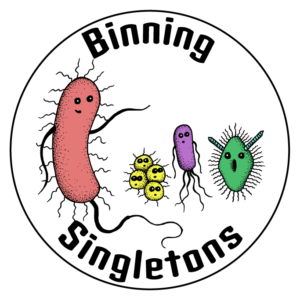 Binning Singletons is a program of mentorship through peer-to-peer networking first implemented at the American Society for Microbiology (ASM) Microbe meeting in 2019. We match volunteer mentors (experienced attendees) with “Singletons” – attendees coming for the first-time, coming alone, suffering impostor syndrome, hoping to improve networking, or any number of other reasons one might feel intimidated at a meeting as large as ASM Microbe. The pilot effort was quite successful and made ASM Microbe a more positive and less intimidating experience for our Singletons.
Binning Singletons is a program of mentorship through peer-to-peer networking first implemented at the American Society for Microbiology (ASM) Microbe meeting in 2019. We match volunteer mentors (experienced attendees) with “Singletons” – attendees coming for the first-time, coming alone, suffering impostor syndrome, hoping to improve networking, or any number of other reasons one might feel intimidated at a meeting as large as ASM Microbe. The pilot effort was quite successful and made ASM Microbe a more positive and less intimidating experience for our Singletons.
We partnered with ASM and the Federation of European Microbiological Societies (FEMS) at the World Microbe Forum, a virtual meeting held in 2021. Here’s how it went!
5 Pillars of Binning Singletons
-
Identify The Singletons: in some DNA analysis pipelines, especially when looking at 16S data (major gene we look at for bacteria identification), a sequence that appears only once is called a Singleton. Most of the time we throw out the singletons to get rid of the noise and any potential errors, but just because a sequence shows up once, it doesn’t mean it is an error. It could be really important, yet it is cast aside. The analogy to someone coming to a meeting alone is a pretty short leap. Of course, we also wanted to include people who were coming to a meeting for the first time or felt isolated for any reason.
-
Bin The Singletons: Microbial sequences can be messy and hard to differentiate. A common practice is to bin sequences based on criteria such as similarity. So the next part of Binning Singletons is to take all the singletons and bin or group them together based on similar fields. Each group could consist of some post-docs, some PhDs and some Undergrads. Each group is then given a mentor to act as a meeting coach. This then becomes a cohort at the meetings. These cohorts can go grab a coffee, talk to vendors, find all the free swag or cool talks that are related to their interest!
-
Horizontal Transfer: Remember when I said microbial sequences are messy, well horizontal gene transfer is the reason why. Bacteria can swap genes across species. This exchange of information can be really difficult when you are trying to identify a certain microbe; however, sharing information can be a great way for conference participants to learn.
-
Quorum Sensing: In the simplest terms, quorum sensing is how microbes communicate with each other. In bacteria, this occurs when bacterial cells regulate gene expression in response to changes in cell density. For the purposes of the Binning Singletons program, it describes getting all the different bins of singletons together at a mixer. This helps the participants feel like part of something bigger, to start really forming their mentorship network and helps with imposter syndrome. Mentors introduce their singletons to other mentors and provide even more connections to grow a professional network. The groups now have a bigger pool of people to socialize with, an incredibly important part of these meetings.
-
Exponential Growth: This one seems self-explanatory. When a singleton becomes part of a larger network they have a supportive mentor or the foundation of a mentorship network and they will feel less anxious and more confident. This will help each singleton to exponentially grow into their best self!
